Module 11 Unit 3 Language in use课件 2023-2024学年度外研版英语七年级下册
文档属性
| 名称 | Module 11 Unit 3 Language in use课件 2023-2024学年度外研版英语七年级下册 |
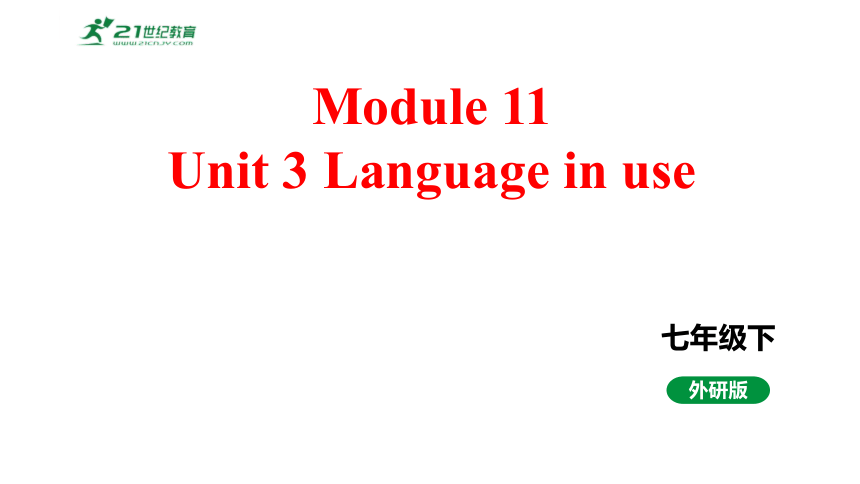
|
|
| 格式 | pptx | ||
| 文件大小 | 31.1MB | ||
| 资源类型 | 试卷 | ||
| 版本资源 | 外研版 | ||
| 科目 | 英语 | ||
| 更新时间 | 2024-02-09 17:59:15 | ||
图片预览

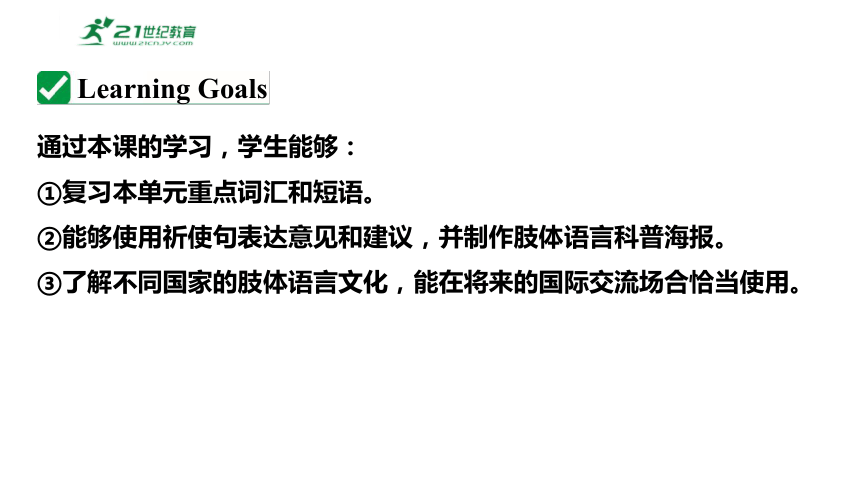
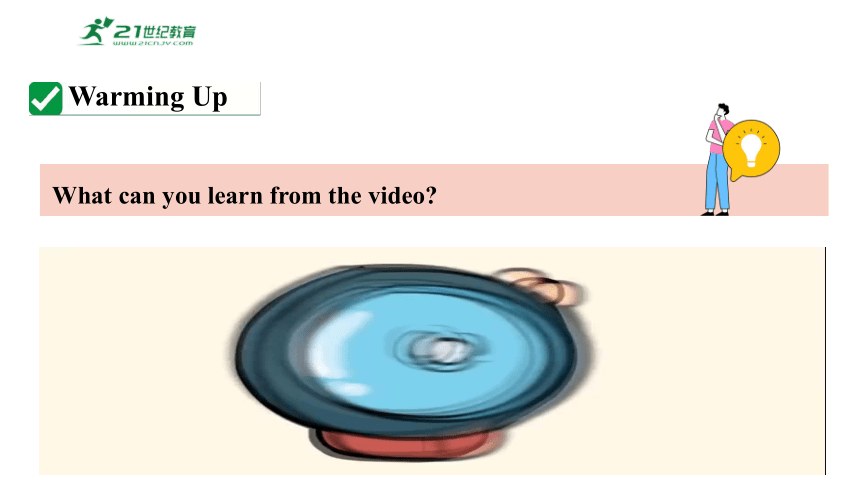
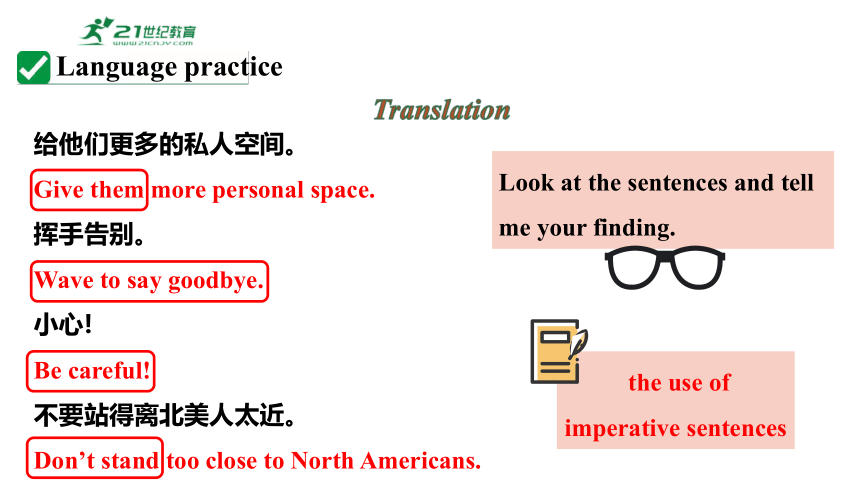
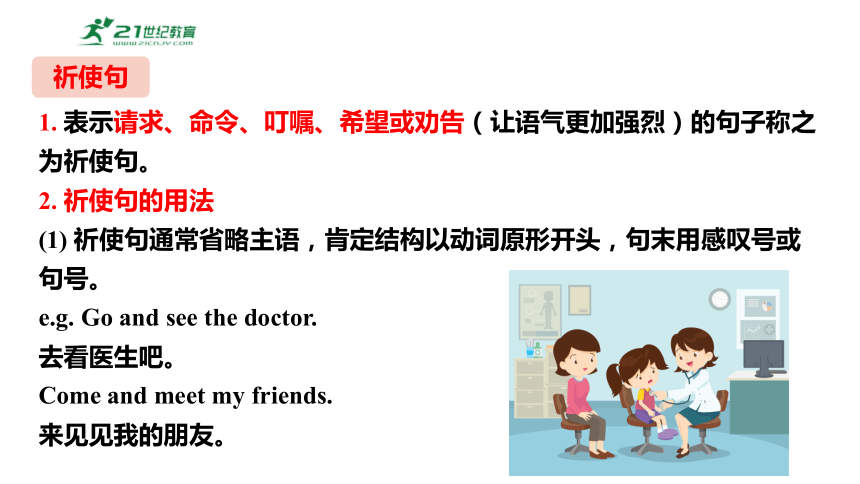
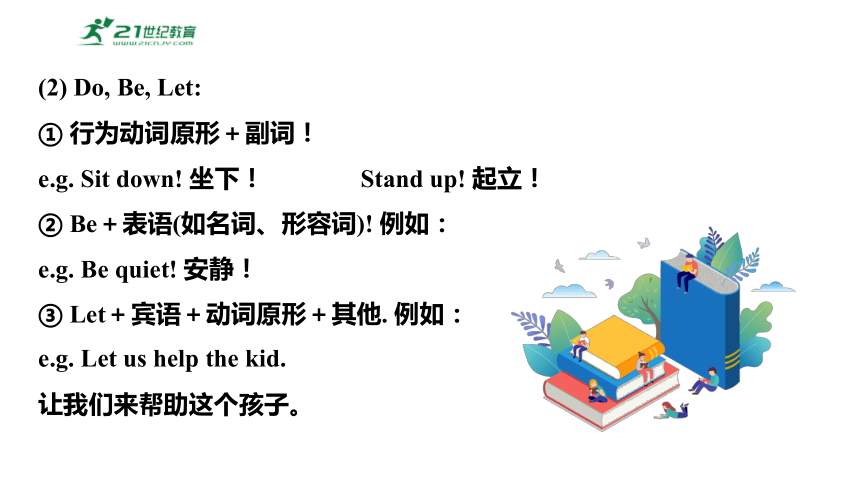
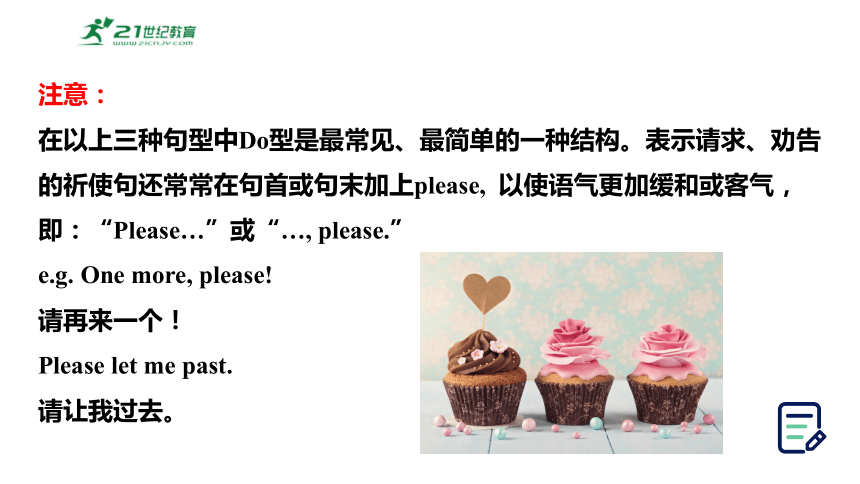


文档简介
(共24张PPT)
Module 11
Unit 3 Language in use
七年级下
外研版
Learning Goals
通过本课的学习,学生能够:
①复习本单元重点词汇和短语。
②能够使用祈使句表达意见和建议,并制作肢体语言科普海报。
③了解不同国家的肢体语言文化,能在将来的国际交流场合恰当使用。
What can you learn from the video
Warming Up
给他们更多的私人空间。
挥手告别。
小心!
不要站得离北美人太近。
Give them more personal space.
Wave to say goodbye.
Be careful!
Don’t stand too close to North Americans.
Look at the sentences and tell me your finding.
the use of imperative sentences
Language practice
Translation
1. 表示请求、命令、叮嘱、希望或劝告(让语气更加强烈)的句子称之为祈使句。
2. 祈使句的用法
(1) 祈使句通常省略主语,肯定结构以动词原形开头,句末用感叹号或句号。
e.g. Go and see the doctor.
去看医生吧。
Come and meet my friends.
来见见我的朋友。
祈使句
(2) Do, Be, Let:
① 行为动词原形+副词!
e.g. Sit down! 坐下! Stand up! 起立!
② Be+表语(如名词、形容词)! 例如:
e.g. Be quiet! 安静!
③ Let+宾语+动词原形+其他. 例如:
e.g. Let us help the kid.
让我们来帮助这个孩子。
注意:
在以上三种句型中Do型是最常见、最简单的一种结构。表示请求、劝告的祈使句还常常在句首或句末加上please, 以使语气更加缓和或客气,即:“Please…”或“…, please.”
e.g. One more, please!
请再来一个!
Please let me past.
请让我过去。
(3) 祈使句的否定结构:
“Don’t+动词原形+其他.”
e.g. Don’t get your dress dirty!
别把你的连衣裙弄脏了!
Don’t be late.
不要迟到。
补充:以Let开头的祈使句,如果Let的宾语为第一人称时,可在句首加Don’t,也可在Let 后的宾语后加not。若宾语是第三人称,其否定式常为let前加don’t。
e.g. Don’t let me form bad habits.
= Let me not form bad habits.
请不要让我养成不好的习惯。
Don’t let him get away.
别让他跑了。
1. Work in pairs. Talk about do’s and don’ts in a foreign country.
Do’s Don’ts
Britain · Stand in line. · Shake hands. · Say “please” and “thank you”. · Open doors for others. · Look at people when you talk. · Be on time. · Touch people.
· Ask a woman’s age.
· Stand too close.
· Say anything too
personal.
2. Make a list of do’s and don’ts to help visitors to Britain.
Stand in line.
Don’t touch people when you talk to them.
…
Do shake hands when you meet a friend.
Do stand in line.
Do expect rain.
Please talk about the weather.
Do say “please” and “thank you”.
Do look at people when you talk.
Don’t touch people.
Don’t ask people personal questions.
Don’t ask a woman’s age.
Don’t talk with food in your mouth.
Don’t be late.
3. Rewrite the sentences.
It’s important to listen to the teacher.
Listen to the teacher.
You cannot shout in the classroom.
Don’t shout in the classroom.
1. It’s important to be careful.
2. It’s important to clean and tidy the lab.
3. You cannot touch anything if the teacher doesn’t ask you to.
4. You cannot bring food or drink into the lab.
5. You cannot enter the lab alone.
Be careful.
Clean and tidy the lab.
Don’t touch anything if the teacher doesn’t ask you to.
Don’t bring food or drink into the lab.
Don’t enter the lab alone.
4. Answer the questions. Use the words and expressions from the box to help you.
all right arm in arm close different hold on to
kiss three times point at shake hands with wave
1. How do the British say hello to each other when they first meet
2. Does body language mean the same thing in different countries
They shake hands with each other.
No, it doesn’t.
all right arm in arm close different hold on to
kiss three times point at shake hands with wave
3. How do the Russians say hello to each other when they meet
4. Is it polite to stand close to North Americans
5. Is it all right to wave goodbye in Greece
They usually kiss three times.
No, it isn’t.
No, it isn’t.
all right arm in arm close different hold on to
kiss three times point at shake hands with wave
6. How do you usually say goodbye with body language
I wave my hand.
Look at the picture and describe what you can see.
Do you think customs like bowing will ever change
Around the world
The Japanese bow
In Japan, people bow to say “thank you”, “sorry”, “hello”, “goodbye”, “you’re welcome”, “excuse me”, and many other things. Children and young people bow lower when they greet older people. It’s a way of being
polite and showing respect.
表示尊重
/ b ; ba /v. 鞠躬;点头
/ ɡri t /v. 和(某人)打招呼(或问好)
5. Work in pairs. Talk about different ways of saying hello and body language in China.
Making a poster about body language
Work in pairs of 3-4.
Discuss different ways of saying hello
and welcoming them.
Take notes while discussing.
Module task
6. Write the information on your poster.
Your time~
7. Find or draw some pictures to add to your poster.
8. Show your poster to the whole class.
1.Grammar:
To summarise and consolidate the use of imperative sentences
To be able to make suggestions using imperative sentences
2. Reading:
The Japanese bow
Summary
Module 11
Unit 3 Language in use
七年级下
外研版
Learning Goals
通过本课的学习,学生能够:
①复习本单元重点词汇和短语。
②能够使用祈使句表达意见和建议,并制作肢体语言科普海报。
③了解不同国家的肢体语言文化,能在将来的国际交流场合恰当使用。
What can you learn from the video
Warming Up
给他们更多的私人空间。
挥手告别。
小心!
不要站得离北美人太近。
Give them more personal space.
Wave to say goodbye.
Be careful!
Don’t stand too close to North Americans.
Look at the sentences and tell me your finding.
the use of imperative sentences
Language practice
Translation
1. 表示请求、命令、叮嘱、希望或劝告(让语气更加强烈)的句子称之为祈使句。
2. 祈使句的用法
(1) 祈使句通常省略主语,肯定结构以动词原形开头,句末用感叹号或句号。
e.g. Go and see the doctor.
去看医生吧。
Come and meet my friends.
来见见我的朋友。
祈使句
(2) Do, Be, Let:
① 行为动词原形+副词!
e.g. Sit down! 坐下! Stand up! 起立!
② Be+表语(如名词、形容词)! 例如:
e.g. Be quiet! 安静!
③ Let+宾语+动词原形+其他. 例如:
e.g. Let us help the kid.
让我们来帮助这个孩子。
注意:
在以上三种句型中Do型是最常见、最简单的一种结构。表示请求、劝告的祈使句还常常在句首或句末加上please, 以使语气更加缓和或客气,即:“Please…”或“…, please.”
e.g. One more, please!
请再来一个!
Please let me past.
请让我过去。
(3) 祈使句的否定结构:
“Don’t+动词原形+其他.”
e.g. Don’t get your dress dirty!
别把你的连衣裙弄脏了!
Don’t be late.
不要迟到。
补充:以Let开头的祈使句,如果Let的宾语为第一人称时,可在句首加Don’t,也可在Let 后的宾语后加not。若宾语是第三人称,其否定式常为let前加don’t。
e.g. Don’t let me form bad habits.
= Let me not form bad habits.
请不要让我养成不好的习惯。
Don’t let him get away.
别让他跑了。
1. Work in pairs. Talk about do’s and don’ts in a foreign country.
Do’s Don’ts
Britain · Stand in line. · Shake hands. · Say “please” and “thank you”. · Open doors for others. · Look at people when you talk. · Be on time. · Touch people.
· Ask a woman’s age.
· Stand too close.
· Say anything too
personal.
2. Make a list of do’s and don’ts to help visitors to Britain.
Stand in line.
Don’t touch people when you talk to them.
…
Do shake hands when you meet a friend.
Do stand in line.
Do expect rain.
Please talk about the weather.
Do say “please” and “thank you”.
Do look at people when you talk.
Don’t touch people.
Don’t ask people personal questions.
Don’t ask a woman’s age.
Don’t talk with food in your mouth.
Don’t be late.
3. Rewrite the sentences.
It’s important to listen to the teacher.
Listen to the teacher.
You cannot shout in the classroom.
Don’t shout in the classroom.
1. It’s important to be careful.
2. It’s important to clean and tidy the lab.
3. You cannot touch anything if the teacher doesn’t ask you to.
4. You cannot bring food or drink into the lab.
5. You cannot enter the lab alone.
Be careful.
Clean and tidy the lab.
Don’t touch anything if the teacher doesn’t ask you to.
Don’t bring food or drink into the lab.
Don’t enter the lab alone.
4. Answer the questions. Use the words and expressions from the box to help you.
all right arm in arm close different hold on to
kiss three times point at shake hands with wave
1. How do the British say hello to each other when they first meet
2. Does body language mean the same thing in different countries
They shake hands with each other.
No, it doesn’t.
all right arm in arm close different hold on to
kiss three times point at shake hands with wave
3. How do the Russians say hello to each other when they meet
4. Is it polite to stand close to North Americans
5. Is it all right to wave goodbye in Greece
They usually kiss three times.
No, it isn’t.
No, it isn’t.
all right arm in arm close different hold on to
kiss three times point at shake hands with wave
6. How do you usually say goodbye with body language
I wave my hand.
Look at the picture and describe what you can see.
Do you think customs like bowing will ever change
Around the world
The Japanese bow
In Japan, people bow to say “thank you”, “sorry”, “hello”, “goodbye”, “you’re welcome”, “excuse me”, and many other things. Children and young people bow lower when they greet older people. It’s a way of being
polite and showing respect.
表示尊重
/ b ; ba /v. 鞠躬;点头
/ ɡri t /v. 和(某人)打招呼(或问好)
5. Work in pairs. Talk about different ways of saying hello and body language in China.
Making a poster about body language
Work in pairs of 3-4.
Discuss different ways of saying hello
and welcoming them.
Take notes while discussing.
Module task
6. Write the information on your poster.
Your time~
7. Find or draw some pictures to add to your poster.
8. Show your poster to the whole class.
1.Grammar:
To summarise and consolidate the use of imperative sentences
To be able to make suggestions using imperative sentences
2. Reading:
The Japanese bow
Summary
同课章节目录
- Module 1 Lost and found
- Unit 1 Whose bag is this?
- Unit 2 Are they yours?
- Unit 3 Language in use
- Module 2 What can you do ?
- Unit 1 I can play the piano
- Unit 2 I can run really fast
- Unit 3 Language in use
- Module 3 Making plans
- Unit 1 What are you going to do at the weekends?
- Unit 2 We're going to cheer the players.
- Unit 3 Language in use
- Module 4 Life in the future
- Unit 1 Everyone will study at home
- Unit 2 Every family will have a small plane.
- Unit 3 Language in use
- Module 5 Shopping
- Unit 1 What can I do for you?
- Unit 2 You can buy everything on the Internet
- Unit 3 Language in use
- Module 6 Around town
- Unit 1 Could you tell me how to get to the Nationa
- Unit 2 The London Eye is on your right.
- Unit 3 Language in use
- Revision module A
- Module 7 My past life
- Unit 1 I was born in a small village.
- Unit 2 I was born in Quincy.
- Unit 3 Language in use
- Module 8 Story time
- Unit 1 Once upon a time….
- Unit 2 Goldilocks hurried out of the house.
- Unit 3 Language in use
- Module 9 Life history
- Unit 1 He left school and began work at the age of
- Unit 2 He decided to be an actor.
- Unit 3 Language in use
- Module 10 A holiday journey
- Unit 1 What did you do?
- Unit 2 This morning we took a walk.
- Unit 3 Language in use
- Module 11 Body language
- Unit 1 They touch noses!
- Unit 2 Here are some ways to welcome them.
- Unit 3 Language in use
- Module 12 Western music
- Unit 1 It's so beautiful!
- Unit 2 Vienna is the centre of European classical
- Unit 3 Language in use
- Revision module B
